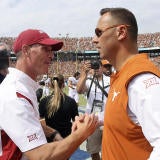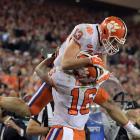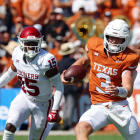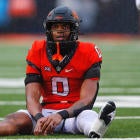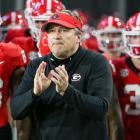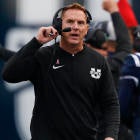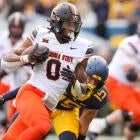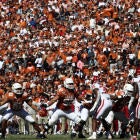It seemed strange that a student manager was dressing in the middle of the Clemson locker room.
Last New Year's Eve, that center of that locker room practically pulsed. It was reserved for the heart of the celebration after the Tigers had skunked Ohio State 31-0 in a College Football Playoff semifinal.
Curious, then, that an unassuming student manager calmly walked to a locker that noisy night and began pulling off a grass-stained No. 13 jersey.
"No," a real student manager pointed out to a clueless media member, "that's Hunter Renfrow."
And that's how we got to a place where an undersized, underappreciated and eventually uncovered boy king of a receiver allowed us to look at the sport a new way.
In case you forgot, it was Renfrow -- a 5-foot-11, 180-pound former walk-on -- who caught the game-winning pass with a second left to beat No. 1 Alabama 35-31 in the CFP National Championship.
That popped the cork on the celebration and reinforced a point. In that moment, Renfrow made his 17th catch, totaling 128 yards while scoring his fourth touchdown in two championship games against one of the best defenses of the modern age.
Renfrow did all of it as a slot receiver, the player typically lined up between the last offensive lineman/tight end and a wide receiver. In the age of the spread offense, the slot receiver has become both integral and overlooked … small but fast, slight but resilient.
A game of giants has to account for a position that largely features the smallest players on the field. The latest test of that position's mettle comes Saturday when No. 13 Auburn travels to No. 3 Clemson.
"Renfrow actually is a good buddy of mine," said Oklahoma State quarterback Mason Rudolph, the nation's third-leading returning career passer. Both he and Renfrow are South Carolina natives.
The difference being that the 6-foot-5, 230-pound Rudolph has an NFL future. Renfrow, a redshirt junior, has two more years before he takes advantage of that economics major.
"He's a baller, man," Rudolph continued. "You see him and he's an Average Joe, but he plays his butt off."
It wasn't too long ago guys with the dimensions of Renfrow would actually be that student manager. Then the game came back to them.
"You need a lot of different tools is the best way I can say it [to succeed] at that position," Clemson coach Dabo Swinney said. "There's certain things that go on in the slot."
Current Tulsa coach Philip Montgomery remembers scouting a 5-foot-11 Danny Amendola out of The Woodlands, Texas, while at the University of Houston.
"Art Briles and I are standing next to each other going, 'Really? Really?'" Montgomery recalled. "Great high school player, but it probably ends right there."
A calendar year's worth of catches later (365), Amendola is going into this 10th year in the NFL.
"The offenses have something to do with it," Montgomery said. "First of all, the slot receiver has got to be kind of fearless in there. He's going to take shots. He's got to be headsy. He doesn't have to be the fastest guy, but he's got to have enough quickness to get open and be sure-handed, a guy quarterbacks trust."
"More than anything," Billy Napier added. "Renfrow and a lot of the guys you're talking about are extremely instinctive."
Napier is currently Arizona State's offensive coordinator. He was the Alabama receivers coach that night against Clemson.
"There is a certain level of comfort in that as a quarterback. You can't ignore production."
If he wasn't the best player on the field in the champ game -- teammate Deshaun Watson was the offensive MVP -- Renfrow may have been the most overlooked.
"I respect him 110 percent," Tide All-American defensive back Minkah Fitzpatrick said. "He's not your typical slot receiver. He finds little windows. It wasn't like he was just blowing past us. He'd be catching these little 6-yard options routes. It was more like a Wes Welker or Julian Edelman. They're not 6-3, 200 either."
It has been an offseason of glory for Renfrow and one of reckoning for college football. Bill Belichick's Patriots have long dominated the NFL with those prototype slots -- Welker, Edelman and Amendola. The three-down Canadian Football League has long made a living with such players.
College coaches have to find players for the position who often don't look like they can play college football. Unlike the NFL, slot receivers aren't refined at that level heading from high school to college. They have to grow into the prototype -- good hands, accurate route runners, effective blockers and incredible toughness.
Playing in limited space, they're always, always going to get hit.
"I know as much about the spread as anybody," Washington State coach Mike Leach said. "You're allowed to innovate and create and attack the field with the most people possible."
And with the most athletically diverse people possible. Leach was among those who refined the position on the college level. About 17 years ago, he stumbled upon the tape of a tiny all-purpose player out of Heritage Hall School in Oklahoma City.
"It's the greatest high school tape you've seen in your life," Leach stressed. "It truly, truly, truly is."
In the 2A state high school game against Tshomingo, the kid accounted for 58 rushing yards, 93 receiving yards, an interception, a field goal and both the game-tying touchdown and game-winning extra point with less than a minute to go.
"We talked about it for a minute and gave Wes Welker a scholarship," Leach said. "We figured it couldn't hurt. We figured he'd be a good team guy."
Welker turned out to be much more than that. He remains college football's all-time leader in punt return yardage and is tied for career touchdowns while having touched the ball 521 times in four seasons.
As a 5-foot-9, 185-pound pro, he became a Patriots poster boy for the slot receiver position playing in five Pro Bowls.
"I started calling him 'Chicken Hawk,' Leach said. "I don't think Wes watched a lot of 'Foghorn Leghorn.' It kind of pissed him off. We meant it as the ultimate compliment. That's the 'Gunsmoke' of cartoons."
Renfrow and his peers are the latest reincarnation of those Chicken Hawks. The importance of the position allowed Oklahoma to pursue 148-pound junior college transfer Marquise Brown from the College of the Canyons in Santa Clarita, California. (Don't worry, he's up to a hefty 162 and third team in the latest depth chart.)
It allowed Nebraska coach Mike Riley to target JD Spielman, the adopted son of Minnesota Vikings general manager Rick Spielman and nephew of Ohio State great Chris Spielman.
JD is a 5-foot-9, 180-pound former Minnesota high school player of the year. Riley found him while working with Chris Spielman on an College Football Playoff show in January. Chris whipped out his cell phone and proudly showed Riley his nephew.
"That video turned into us signing JD," Riley said.
Oklahoma State coach Mike Gundy can boast of one of the nation's deepest receiving corps. At 5-foot-10, 156 pounds, Jalen McCleskey led the Cowboys with 73 catches last season. That's in a lineup that includes preseason All-American James Washington.
"Bill Belichick made a living on these guys," Gundy said. "He takes guys who are intelligent, cerebral, and they're loyal. Coaches don't have to worry about unselfishness."
Use them any way you want: Belichick took a chance on technically sound, undersized pass catchers as part of the foundation for a dynasty. Oklahoma took a lightweight (in pounds only) from a KICP.
Spielman was Nebraska's second-most productive receiver (two catches, 44 yards) in his career debut against Arkansas State.
"Those [slot] guys are fun to coach," Riley said, "because they know who they are and what they have to do."
Renfrow knew exactly what he had to do on that last play against Alabama. Its execution and result have become one of the most debated subjects of the offseason.
Lined up in the right slot with a second to go against Bama, Renfrow took advantage of teammate Artavis Scott cracking down from the outside on Alabama defensive back Marlon Humphrey.
Renfrow slipped out toward the sideline catching the last pass of Deshaun Watson's career deciding a game for the ages.
Depending with whom you speak, Scott's play was either offensive pass interference -- a so-called "pick" play -- or a simple screen, similar to basketball to wall off the defense.
Either way, Humphrey found himself hopefully out of the play as a former walk-on slipped into the clear to catch the winning pass.
It also started a national debate in the offseason.
"That should have been a flag," Rice coach David Bailiff said. "Everybody does it all the time. I guess it's like marijuana. It should be legal."
"That's legal," said Auburn coach Gus Malzahn, whose Tigers limited Renfrow to three catches and 27 yards last season. "You know the difference between when somebody really picks and somebody really rubs."
"Rubbin's racin'," Montgomery said. "That's part of the game."
"That pick play?" Fitzpatrick said. "It was a very controversial call. … They ran it a couple of times. I knew exactly what was coming. I don't think it was legal at all."
Whatever your opinion, the play became a timestamp on the obvious in this era: The little guys can play, too.






